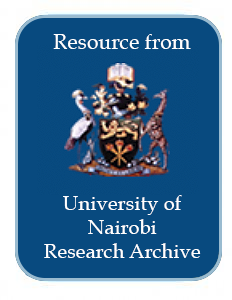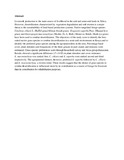Location
Our Vision is to be a world-class university committed to scholarly excellence.
Our Mission is to provide quality university education and training and to embody the aspirations of the Kenyan people and the global community through creation, preservation, integration, transmission and utilization of knowledge.
Core Values
In order to realize the above vision and mission, certain shared values shall be nurtured. There is great need for the University to be guided by the right values derived from the virtues and moral standards of the Kenyan and wider society.
Core Functions
Teaching and Learning: The university offers innovative , relevant and market driven academic programmes , both at undergraduate and postgraduate levels with inbuilt quality control systems the university also provides an environment and policy framework for undertaking high quality and relevant research
Members:
Resources
Displaying 81 - 85 of 298A Critical Analysis of the Extent to Which the National Land Commission Addresses the Land Question in Kenya
The land question in Kenya has never been solved. Land is a pertinent source of livelihood, the problem has persisted and in a number of years caused chaos as people grow impatient. Over time, there have been complaints from various communities and recently, the past governments have sought to listen the ailing communities. The National Land Policy and the National Land Commission characterize efforts to remedy the continued situation bedeviling the African communities.
A Critical Analysis of the Extent to Which the National Land Commission Addresses the Land Question in Kenya
The land question in Kenya has never been solved. Land is a pertinent source of livelihood, the problem has persisted and in a number of years caused chaos as people grow impatient. Over time, there have been complaints from various communities and recently, the past governments have sought to listen the ailing communities. The National Land Policy and the National Land Commission characterize efforts to remedy the continued situation bedeviling the African communities.
Special issue: Securing the land and resource rights of pastoral peoples in East Africa
The land question in many African countries has geographical, political, economic, social and demographic nuances. These factors color land and resource rights for pastoral and forest dwelling communities. Land as property draws from the universality of the theory of property in time and space with the earliest theoretical explanations of property being occupation of land and where property belonged of right to him who seized it first. Land therefore represents the earliest form of property and includes resources on the land such as trees; pasture; water and wetlands.
The choice of grass species to combat desertification in semi-arid Kenyan rangelands is greatly influenced by their forage value for livestock
Livestock production is the main source of livelihood in the arid and semi-arid lands in Africa. However, desertification characterized by vegetation degradation and soil erosion is a major threat to the sustainability of land-based production systems. Native rangeland forage species Cenchrus ciliaris L. (Buffel grass/African foxtail grass), Eragrostis superba Peyr. (Maasai love grass) and Enteropogon macrostachyus (Hochst. Ex A. Rich.) Monro ex Benth. (Bush rye grass) have been used to combat desertification.
Nitrogen Fixation by Natural Populations of Acacia Senegal in the Drylands of Kenya Using 15N Natural Abundance
Nitrogen (N) fixation was estimated for three Acacia senegal (L.) (A. senegal) Willd. varieties (A. senegal var. senegal, kerensis, and leiorhachis) growing naturally in different sites in the dryland areas of Kenya. The quantities of N2 fixed were estimated by the 15N natural abundance method, using leaves as the sampling material. Balanites aegyptiaca (B. aegyptiaca) was selected as the reference species growing in the same area. Soil samples were also collected under A. senegal trees for nodule assessment. Leaf 15N natural abundance values (δ15N) were significantly different between A.




